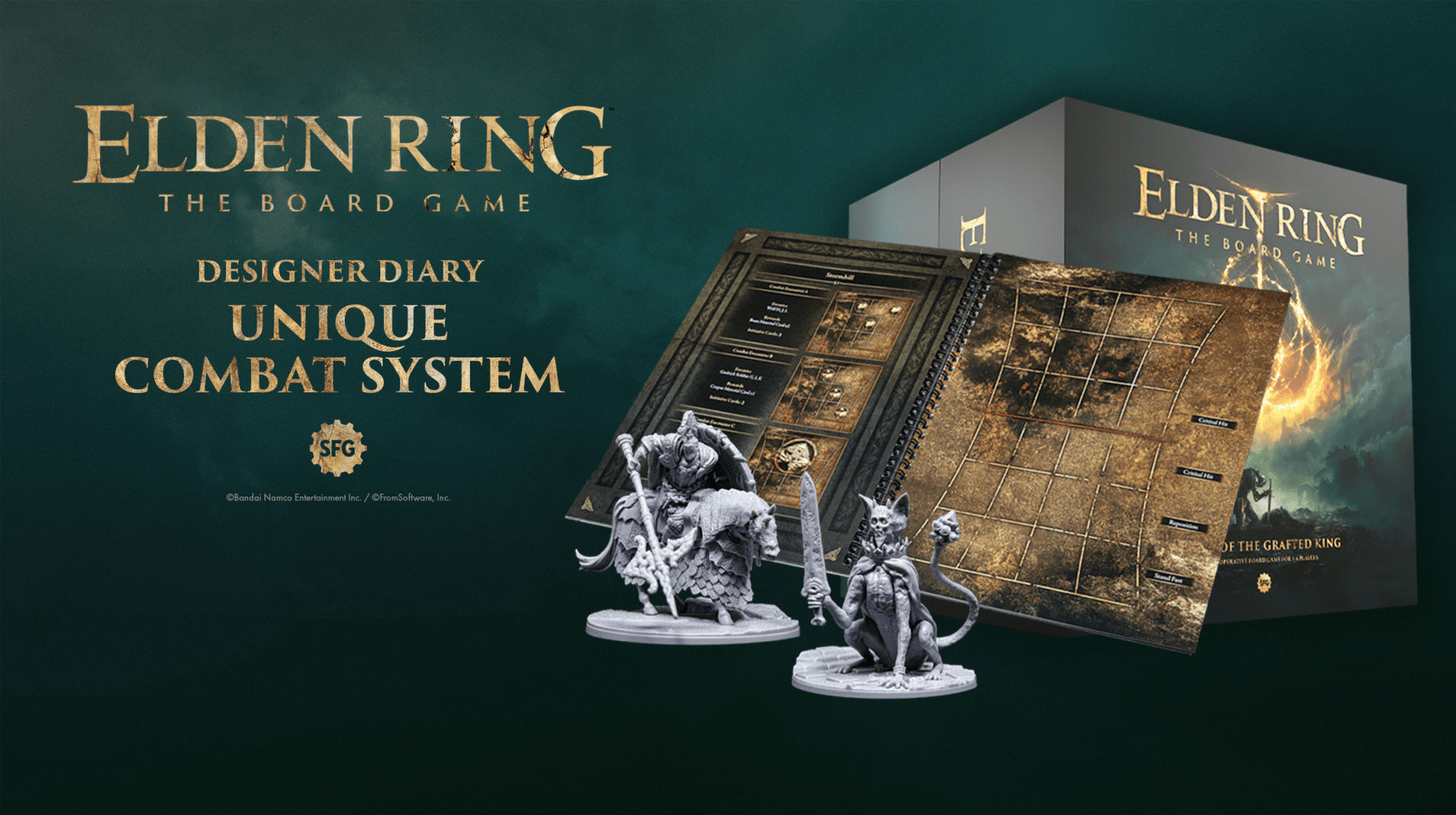Hi, this is Lead Designer, Fraser McFetridge, and I’m here to share a look at a game system that’s been years in design, and we’re very excited to bring to the tabletop with ELDEN RING: The Board Game.
First, a brief explanation of how it works.
The Grid
The grid itself is made up of horizontal rows and (slightly warped) vertical lanes of squares. There’s a good reason for this, which I’ll get to in a minute.
It’s then split into two halves – one for player characters (Tarnished) and one for enemies. Characters can’t go into the enemy half, and enemies can go into the player’s half.
So far so simple, but here’s where we start to abstract things a bit. The lanes represent space, as you might expect. The rows, however, represent ‘stance’. More particularly, the closer the lane is to the other half of the grid, the more aggressive stance.
So, two miniatures that share a lane are, in real-world terms, standing right next to each other. And depending on how close each is to the other within that lane could mean anything from them bellowing war cries at one another, ready to strike, to having shields raised, prepared to defend any opposing attacks with ease.
We achieve this, in board game terms, with ‘row effects’. Miniatures gain certain advantages (or disadvantages) depending on the row(s) they occupy. These apply to both halves of the grid, and can have highly varied effects on different grids, for different enemies.
What This Brings to the Game
We know, as game designers, that we need to have a really good reason to use abstraction when players aren't expecting it. So, let me break down why we’ve made the decision to use this system, and why ELDEN RING: The Board Game is the perfect fit for it.
At its most basic level, the Elden Ring video game is about timing windows. There are moments where every enemy, from the lowly Godrick Solder the the Grafted King himself (and beyond), are vulnerable to attacks. There are also moments where they are extremely dangerous. Attack at the right moment, with a full FP and stamina bars, and you’ll inflict a lot of damage and get away unscathed. Attack at the wrong moment and you’ll quickly find yourself on a one-way trip to a Site of Grace.
We use the Battlefield Grid system to emulate this. Through a combination of different overlapping game mechanics – the marching order, enemy behaviour design, Tarnished combat card hand management, to name a few – enemies have windows where they’re vulnerable, and when they’re dangerous.
Through clever observation, players can predict these windows and plan accordingly. When enemies are dangerous, it’s best to be in the back row, and gain a defensive benefit. If you don’t, there’s a good chance you end up dead before the window closes. Likewise, when the enemies are vulnerable, it pays to be in the front row, to empower your attacks.
Not only does this create interesting, evolving and replayable combat puzzles, but it has a distinct side effect on elevating the gameplay of a very traditional mechanical concept – mobility.
Within this system, movement can not only be used to close and create space between your character and enemies, but it can translate directly into utility and stats by switching between rows. It also opens up a lot of new design space with ability design, when we separate horizontal movement from vertical.
And that’s just the Tarnished half.
As you can imagine, the row effects on the enemy half of the grid also carry a lot of weight in determining these windows. While the specific row effects can vary greatly from grid to grid, they typically make the enemy tougher to damage at the back, and deal more damage to Tarnished at the front. In addition, they can also give advantages to Tarnished, when the enemy has been maneuvered into a disadvantageous stance.
So, much like the Tarnished half of the grid, giving new depth the character mobility, the enemy half does the same for effects that move enemies around, like pushes. With this system, the stock-standard ‘push’ effect can not only move spatially, but can be vital in breaking an opponents stance, creating vulnerabilities that can be capitalised on.
Featuring a huge variety of different battlefield grids and row effects, the breadth of unique gameplay across each set of ELDEN RING: The Board Game provides players with unparalleled opportunity for engaging, replayable experiences!
If you'd like to see this combat system in action, join Fraser, Steve and Jamie as they take on the mantle of brave Tarnished and battle the formidable Margit Fell Omen in our combat playthrough.
Make sure you join us next time as we share the importance of runes whilst you explore the decaying grandeur of Limgrave.











